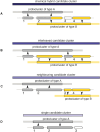antiSMASH 5.0: updates to the secondary metabolite genome mining pipeline
- PMID: 31032519
- PMCID: PMC6602434
- DOI: 10.1093/nar/gkz310
antiSMASH 5.0: updates to the secondary metabolite genome mining pipeline
Abstract
Secondary metabolites produced by bacteria and fungi are an important source of antimicrobials and other bioactive compounds. In recent years, genome mining has seen broad applications in identifying and characterizing new compounds as well as in metabolic engineering. Since 2011, the 'antibiotics and secondary metabolite analysis shell-antiSMASH' (https://antismash.secondarymetabolites.org) has assisted researchers in this, both as a web server and a standalone tool. It has established itself as the most widely used tool for identifying and analysing biosynthetic gene clusters (BGCs) in bacterial and fungal genome sequences. Here, we present an entirely redesigned and extended version 5 of antiSMASH. antiSMASH 5 adds detection rules for clusters encoding the biosynthesis of acyl-amino acids, β-lactones, fungal RiPPs, RaS-RiPPs, polybrominated diphenyl ethers, C-nucleosides, PPY-like ketones and lipolanthines. For type II polyketide synthase-encoding gene clusters, antiSMASH 5 now offers more detailed predictions. The HTML output visualization has been redesigned to improve the navigation and visual representation of annotations. We have again improved the runtime of analysis steps, making it possible to deliver comprehensive annotations for bacterial genomes within a few minutes. A new output file in the standard JavaScript object notation (JSON) format is aimed at downstream tools that process antiSMASH results programmatically.
© The Author(s) 2019. Published by Oxford University Press on behalf of Nucleic Acids Research.
Figures


References
-
- Newman D.J., Cragg G.M. Natural products as sources of new drugs from 1981 to 2014. J. Nat. Prod. 2016; 79:629–661. - PubMed
-
- van der Meij A., Worsley S.F., Hutchings M.I., van Wezel G.P. Chemical ecology of antibiotic production by actinomycetes. FEMS Microbiol. Rev. 2017; 41:392–416. - PubMed
-
- Ziemert N., Alanjary M., Weber T. The evolution of genome mining in microbes - a review. Nat. Prod. Rep. 2016; 33:988–1005. - PubMed
-
- Weber T., Rausch C., Lopez P., Hoof I., Gaykova V., Huson D.H., Wohlleben W. CLUSEAN: a computer-based framework for the automated analysis of bacterial secondary metabolite biosynthetic gene clusters. J. Biotechnol. 2009; 140:13–17. - PubMed
Publication types
MeSH terms
LinkOut - more resources
Full Text Sources
Other Literature Sources

